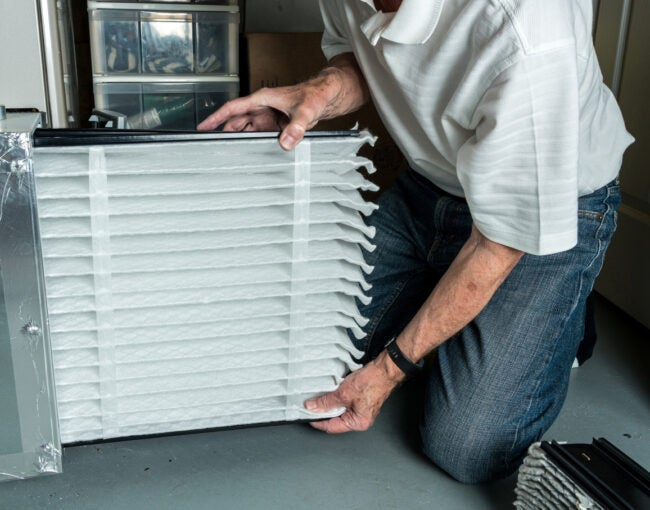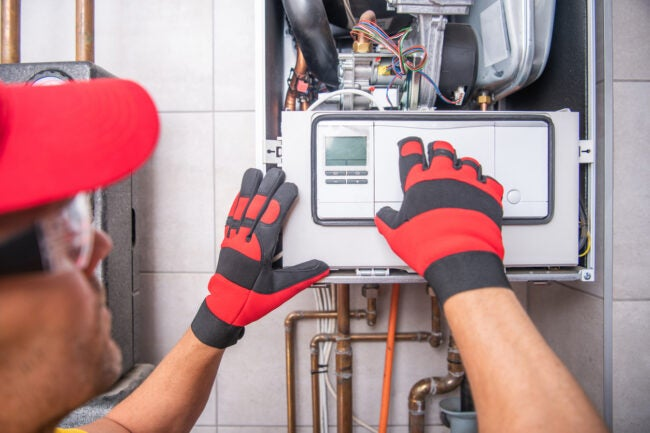It’s easy to get an uncooperative furnace back up and running if you know where and how the problem may be occurring. Try these furnace troubleshooting tips before calling a professional technician.
Q: I recently moved into a house, and when the weather turned cold, I realized my furnace wasn’t turning on. I know it has to start before the ducts freeze, but I don’t know what the problem is. Can you fix the problem of the furnace not turning on instead of calling a technician?
A: In addition to a cold house and gnashing of teeth, a malfunctioning home furnace can cause significant damage, including frozen ducts as you described. Severe cold and condensation can damage window glass, and unheated homes can even suffer structural damage during the freezing winter months.
Keeping your furnace running in cold weather is a top priority and should be addressed immediately, but not necessarily by a repair specialist. If the furnace stops working, there are ways to fix the furnace problem, such as setting the thermostat or, for gas systems, relighting the test light on the furnace. Read on for furnace troubleshooting strategies to try before calling a technician for service.

Make sure the thermostat is on.
The most obvious solution to the problem of a furnace that won’t turn on is often overlooked when troubleshooting a heating system. Many people neglect to check the thermostat, which is the part of the heating system that allows you to assess the room temperature and set and adjust the desired temperature. The thermostat is usually located on one of the main walls of the house, slightly higher than the light switch.
If the thermostat is not on, this unit cannot tell the furnace when to turn on. If you have a programmable thermostat, make sure the display is active, the furnace is turned on, and the unit is set to heat. If you have a manual thermostat, be aware that the switch may be accidentally “turned off” during cleaning, such as dusting. Once the thermostat is confirmed to be on, turn the heat up to the temperature at which the furnace switch normally turns on; if the heat does not turn on after a minute or so, increase the temperature setting significantly and continue troubleshooting.
Make sure the gas is turned on.
Any gas furnace will have a valve or gas valve within 6 feet of the unit. Furnace valves vary in design, but usually include a small disc with a small handle or lever. Some look like a small box, while others resemble an index finger-sized lever (some are brightly colored).
Gas valves can be accidentally turned off, or the furnace operator may forget to open them. Valves vary from manufacturer to manufacturer, but if the handle of the valve is parallel to the pipe, it is usually open (gas flows into the pipe). If the handle is perpendicular to the pipe, the valve will close. To open, turn the small handle so that it is parallel to the pipe.
If the furnace does not turn on when you open the valve, check other gas appliances in the house, such as the stove or fireplace. If other gas appliances are not turning on, there may be no gas coming into the house. This could mean that workers are working on a gas line somewhere, or there could be a gas leak, damage or blockage in the line. A gas leak is a dangerous situation, so if in doubt, call an ambulance immediately and follow their instructions.
To assess the situation, go outside and check that the valves on the road side and the internal valves on the house side are open. If they are not open, turn the valves to the open or open position as described above, which will allow the gas to flow again. If the gas appliance still does not turn on, contact the utility company and check if the utility company is operating in your area or if there has been a service interruption. If not, check the status of your account. A failed or insufficient utility payment, whether due to technical failure or human negligence, can result in a service interruption.
Check the position of your furnace’s power switch.
The furnace may not turn on simply because the power switch is turned off. The furnace’s power switch is located on a nearby wall or on a ceiling or floor joist near the unit. It usually looks like a normal electrical switch and may or may not be labeled. Typically, the “on” position is at the top, but this will vary depending on the installation. It is common for someone unfamiliar with it to mistake it for an electrical switch and turn off the furnace. Return this switch to the “on” position and wait for the appliance to start. It may take several minutes for some furnaces to resume operation.
Replace the air filter.
If the air filter is clogged, the furnace will not heat properly. The air filter may become clogged with dust, hair and other household debris, reducing the efficiency of the furnace. Restricted air flow can also cause the heat exchanger to heat up continuously. All furnaces are equipped with limit switches that are activated to shut off the furnace when the temperature exceeds a specified point. To keep the unit operating efficiently, the furnace’s air filter should be changed every one to three months, even if there are heating or air flow problems.
To locate the filter, look for the area where air flows in while the furnace is running. Slide the old filter out, check the model and size on the side, and find the replacement filter to purchase. When replacing the filter, check the frame for the arrow markings that indicate the direction of air flow. When sliding the new furnace filter into place, make sure the arrow is pointing in the direction of the furnace.

Check the ignition sensor.
If you’re a confident DIYer, you can clean the ignition sensor (also known as the flame sensor) on your furnace. The ignition sensor is a safety device that detects if the furnace is burning gas. The sensor uses the rise in temperature inside the furnace to identify the flame. If the sensor fails to detect a flame, the furnace shuts down to prevent unburned gas from escaping. A buildup of residue will prevent the flame sensor from working properly. Cleaning will turn the furnace back on and allow it to operate properly. If you feel that this troubleshooting is beyond your DIY skills, then it may be time to call a professional. To understand this procedure, refer to the basic steps for cleaning the ignition sensor.
- Before cleaning the sensor, turn off the furnace. To turn off the furnace, locate the gas valve that controls the furnace gas and turn the small handle on the valve to the off or ‘off’ position (perpendicular to the pipe).
- Next, make sure there is a porcelain base with a small metal bar in front of the pilot light in the furnace. Using a suitable screwdriver, loosen and remove the screw next to the sensor and slide the dirty sensor out of its current position.
- Gently clean the metal rod with a bundle of wire balls or a clean straight knife to remove any deposits. Scrub very carefully and patiently to make sure the rod does not come off the base.
- After cleaning, put the sensor back in place, undo the screws holding the sensor in place, and refill it with gas.
If, after trying these solutions, the furnace still won’t turn on, it may be time to consider calling in a furnace repair specialist. Check online catalogs to find a repair technician in your neighborhood. Your local home improvement store can also be a great resource for finding a furnace repair technician.

Final thought.
When your fireplace won’t turn on, you may be tempted to throw your hands up in the air and try to call a carpenter. But before you consult a professional, take a deep breath, straighten your shoulders and try the DIY method yourself. The problem could be something as simple as a dirty filter or a flipped switch, or it could be that your dog ate your gas bill.
Check out our list of repairs. If the furnace still won’t turn on, you can call in an expert to help.
Frequently asked questions about furnaces that won’t turn on
Making sure your furnace turns on when you need it is one of the most important responsibilities a homeowner faces and wants to get done correctly. If you have any questions about this topic, read on.
Q: How does a stove work?
A gas stove burns natural gas or liquefied propane gas in a device called a burner, which produces a small flame. The heat from this flame is fed into the ducts by a fan and the heat travels throughout the house.
Q: How do I reset the power to the furnace?
The furnace unit may be equipped with a reset button. Press and hold this button for a few seconds, then release it. Alternatively, there may be a switch on the wall near the furnace. If this does not work, you may have to reset the circuit breaker for the furnace.
Q: Where is the reset button on the furnace?
Since furnace designs vary from manufacturer to manufacturer, it is best to check the owner’s manual for the furnace reset button for your particular unit. In most cases, it is mounted on the side of the blower motor (in the blower compartment). (If you don’t have the manual handy, look up the model number of your furnace and search online).
Q: How do I know if there is a problem with my thermostat or furnace?
First, check the thermostat’s display. If the display is blank or not responding to adjustments, the thermostat may be faulty. If the display is responding but the furnace is not, troubleshoot the furnace as described above.
Q: How do I check the pilot light on the furnace for problems?
If air is coming out of the vent, but the air is not getting hot, the test light may have gone out. On the furnace unit, look for the panel that covers the pilot light and open it. If you do not see a small blue flame, there is a problem with the pilot light.










